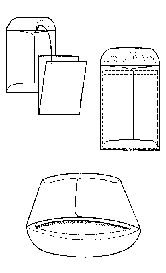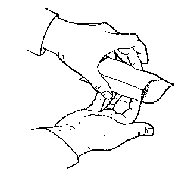|
(Norman Houghton)
This “Three-Way-Envelope” is the best we came across. It is easy to construct (it takes you less than two minutes); it’s immediately reusable and foolproof in its handling.
 Look at the illustrations on the last page. These show clearly its construction. It is made from an opaque, end-opening envelope measu-ring approximately three-and-quarter by four-and-three-quarters inches, and has a double partition fashioned from one piece of paper, nine inches long and folded at the bottom into the shape of an uneven “V”. This folded piece must match the paper stock from which the envelope is made, and is just slightly narrower than the envelope. The partition lying on the flap-side of the envelope is roughly an eight of an inch shorter than the interior of the envelope; and the partition toward the seam-side of the envelope is a quarter of an inch shorter than its companion. Look at the illustrations on the last page. These show clearly its construction. It is made from an opaque, end-opening envelope measu-ring approximately three-and-quarter by four-and-three-quarters inches, and has a double partition fashioned from one piece of paper, nine inches long and folded at the bottom into the shape of an uneven “V”. This folded piece must match the paper stock from which the envelope is made, and is just slightly narrower than the envelope. The partition lying on the flap-side of the envelope is roughly an eight of an inch shorter than the interior of the envelope; and the partition toward the seam-side of the envelope is a quarter of an inch shorter than its companion.
The partitions divide the envelope into three compartments. Each compartment is capable of holding a playing card, providing you with three “outs”. (Six “outs” are possible, if you were to use three double-faced cards, as Mr. Houghton has done in his original “Kismet” effect.)
The greates advantage of the Kismet Envelope ist the natural handling its construction makes possible when you wish to remove one of the three cards it contains. (With this instructions comes a sample Kismet Envelope with three cards already inserted into each compartment.)
Now try this :
With your palm-down left hand, grasp the envelope from above by its opposite long edges, seam-side up and flap opened straight out to the right. The thumb is at the near side, the fingers are at the far side. If you press the thumb and fingers lightly together, the envelope will bow open. As a rule, the two compartments inside will bow apart as well, opening the middle compartment. If you now turn the envelope mouth down, the card from the center compartment will fall out, while the other two cards remain int their compartments, pressed against the inside walls of the envelope by the bowed partitions.

To open the top (seam-side) compartment, press lightly down with your left forefinger on the center of the envelope, just before the left fingers sqeeze the sides. This will curve both paper partitions dwon against the flap-side of the envelope, and the top compartment will bow open. The cards in the middle and bottom compartments are trapped in place, and you can safely tip the top card from the envelope.

If you wish to release the card in the bottom (flap-side) compartment, first press the tip of your right second finger on the underside of the envelope, bowing it upward, before squeezing the sides with the left fingers. This forces both partitions to curve upward against the seam-side of the envelope, and the bottom compartment to gape open.

Should you experience any difficulty in opening the desired compartment, you can quickly remedy the problem by inserting your right thumb or forefinger into the envelopeand pushing open the compartment when required. And if you should find that the center compartment consistently refuses to bow open, separate the thwo partitions with your fingers, then give the sides of the envelope a sharp squeeze, putting a gentle crimp in each partition. This minor preparation before the performance will assure that the center compartment opens properly when required. During performance, of course, you can look into the envelope to make sure that you have opened it to the correct section.
All this is much more difficult to describe than to do. Try it a few times and you will immediately see how simple the operation is.
Tricks and routines with Norman Houghton`s “KISMET ENVELOPE” are limited only by your imagination.
|



 Look at the illustrations on the last page. These show clearly its construction. It is made from an opaque, end-opening envelope measu-ring approximately three-and-quarter by four-and-three-quarters inches, and has a double partition fashioned from one piece of paper, nine inches long and folded at the bottom into the shape of an uneven “V”. This folded piece must match the paper stock from which the envelope is made, and is just slightly narrower than the envelope. The partition lying on the flap-side of the envelope is roughly an eight of an inch shorter than the interior of the envelope; and the partition toward the seam-side of the envelope is a quarter of an inch shorter than its companion.
Look at the illustrations on the last page. These show clearly its construction. It is made from an opaque, end-opening envelope measu-ring approximately three-and-quarter by four-and-three-quarters inches, and has a double partition fashioned from one piece of paper, nine inches long and folded at the bottom into the shape of an uneven “V”. This folded piece must match the paper stock from which the envelope is made, and is just slightly narrower than the envelope. The partition lying on the flap-side of the envelope is roughly an eight of an inch shorter than the interior of the envelope; and the partition toward the seam-side of the envelope is a quarter of an inch shorter than its companion.

